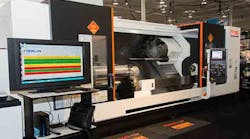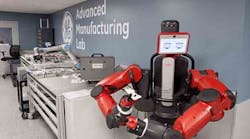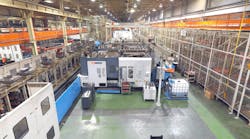Yamazaki Mazak, the machine tool manufacturer and parent company to Kentucky-based Mazak Corp., introduced a new “all-encompassing manufacturing vision” based on advanced manufacturing cells and systems, with full digital integration that will achieve “free-flow data sharing” for process control and operation monitoring. Mazak plans to designate all 10 of its manufacturing operations as iSmart Factories, starting with the plants at Oguchi, Japan, and Florence, Ken.
The 800,000-sq.ft. complex in Kentucky produces about 200 multi-axis turning and milling machines every month. It has undergone a series of modernization and expansion programs over the past decade, notably including a full implementation of the MTConnect, the open communications protocol for data exchange among manufacturing systems.
Mazak added that the iSMART Factory concept relies on MTConnect working with process support software to provide connectivity and monitoring capability, to observe and collect data from shop-floor machines, production cells, monitoring devices and production processes. PCs and portable electronic devices (smartphones, tablets) provide the connection to individual managers and operators.
The result is a responsive system based on real-time manufacturing data that is capable of improving overall productivity efficiency and responsiveness to customer/market changes.
“For Mazak, iSMART Factory is a vision – the complete digital integration of the factory with state-of-the-art manufacturing equipment, automation and advanced manufacturing practices,” according to Mazak Corp. president Brian Papke. “The name establishes a philosophy – a credo of sorts for Mazak that is unique to our operations but symbolizes our commitment toward the ultimate smart factory.”
In addition to the Kentucky plant’s machining operations being integrated by the MTConnect standard, in 2015 Mazak plans to incorporate the factory-floor data with its ERP system.
“While the (iSMART Factory) name is new, our U.S. factory has long demonstrated a commitment to growth and technological advancement, with a critical part of that strategy being such factors as plant-wide connectivity, automation and optimized production flow,” Papke added.










